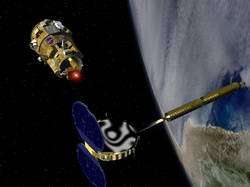NASA's robotic spacecraft to be launched on April 15

After a series of delays, NASA's Demonstration of Autonomous Rendezvous Technology (DART) spacecraft is finally scheduled to launch at 1:21 p.m. EDT, April 15 from Vandenberg Air Force Base, Calif.
DART is a flight demonstrator that provides a key step in establishing autonomous rendezvous capabilities for the U.S. space program. DART will rendezvous with the Multiple Paths, Beyond-Line-of-Site Communications (MUBLCOM) satellite. It will perform several close proximity operations, such as moving toward and away from the satellite using navigation data provided by onboard sensors.
The Demonstration of Autonomous Rendezvous Technology (DART) is a flight demonstrator that provides a key step in establishing autonomous rendezvous capabilities for the U.S. space program. While previous rendezvous and docking efforts have been piloted by astronauts, the unmanned DART spacecraft will have computers and sensors to perform all of its rendezvous functions.
Future applications of technologies developed by the DART project will benefit the nation in future space systems development requiring in-space assembly, services, or other autonomous rendezvous operations.
Once on orbit, DART will travel around the Earth to rendezvous with the target satellite, the Multiple Paths,
Beyond-Line-of-Site Communications (MUBLCOM) satellite, also built by Orbital Sciences. Launched in May 1999, the MUBLCOM satellite was used by the Department of Defense as an experimental communications satellite and was outfitted with optical retro reflectors designed for future use with a video guidance system such as the Advanced Video Guidance Sensor (AVGS) onboard DART.
The AVGS is an advanced version of the Video Guidance Sensor developed by the Marshall Space Flight Center in Huntsville, Ala., for NASA’s Automated Rendezvous and Capture Project, which demonstrated these automated capabilities in the mid-1990s -- including two successful flight tests on board the Space Shuttle. The next-generation AVGS incorporates advanced optics and electronics and allows DART to communicate with and track the MUBLCOM satellite within a range of 5 to 250-plus meters.
Once DART reaches the MUBLCOM satellite, it will perform several autonomous rendezvous and close proximity operations, such as moving toward and away from the satellite using navigation data provided by the AVGS and Global Positioning System (GPS) based information.
DART is the first demonstration program selected by NASA's Exploration Systems Mission Directorate to develop technologies for the Vision for Space Exploration. The Vision calls for the safe return to flight of the Space Shuttle, completion of the International Space Station and human and robotic exploration of the Solar System.
If the 24-hour DART mission is successful, it will lay the foundation for future manned and unmanned projects using similar technology.
Flight demonstrators, like DART, have a critical role in demonstrating technologies that cannot be validated on
the ground. DART will help lay groundwork for future reusable manned and unmanned launch vehicle missions
using autonomous rendezvous operations. Future technology applications may aid in cargo delivery, servicing
missions for the International Space Station and other on-orbit activities, such as satellite retrieval or servicing to enable future civil, defense and commercial space transportation. NASA is pursuing technologies that will enable the Agency to achieve its goals of establishing safe, reliable, affordable access to space.
Source: NASA















